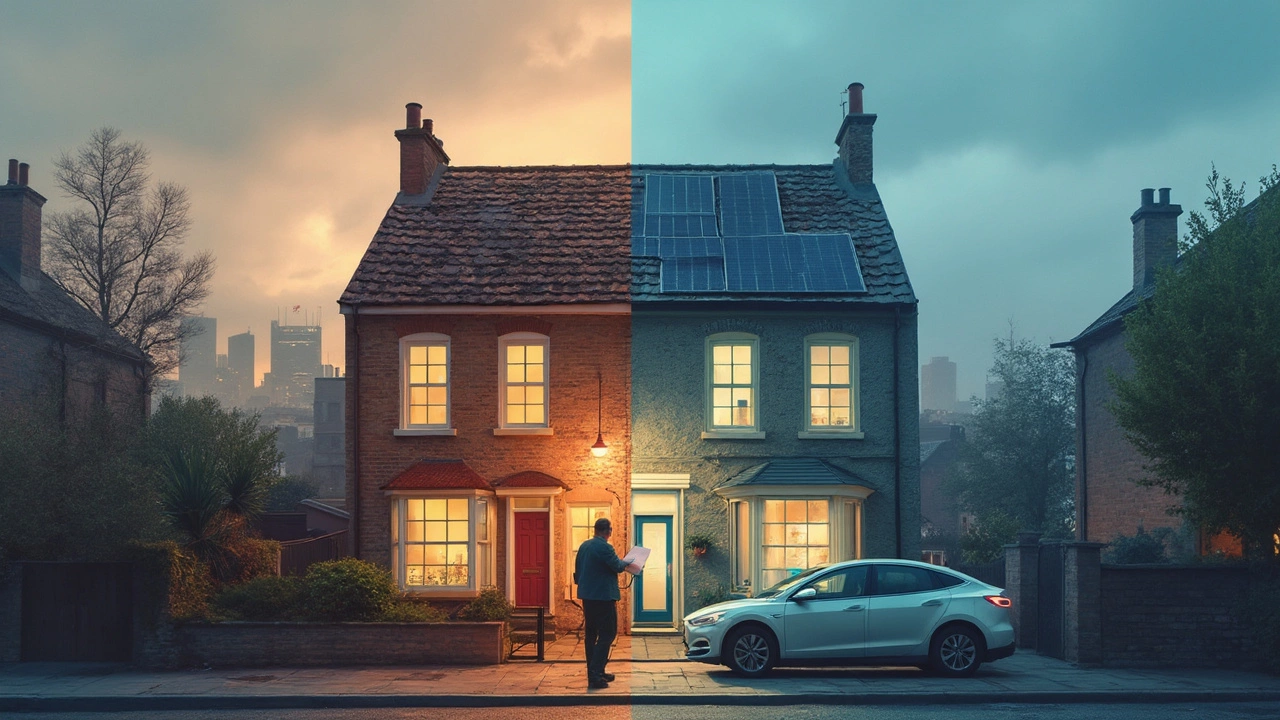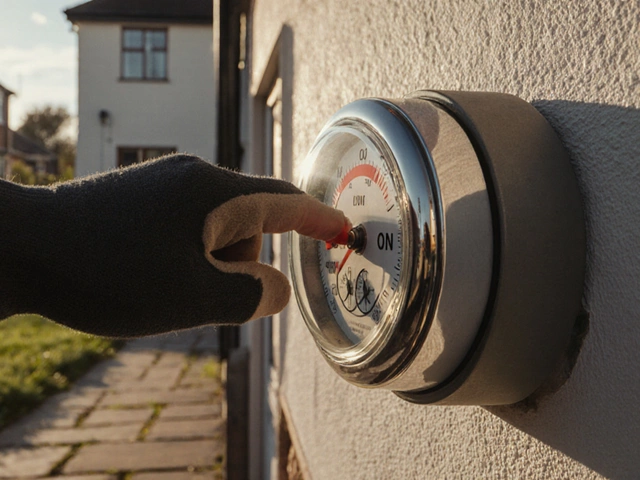Kitchens used to be all about the click and whoosh of a gas flame under your favorite pan. But lately, a lot of folks are wondering if it's time to swap out those trusty gas appliances for something cleaner and newer. It’s not just talk either—some cities are banning new gas hookups, while energy companies keep pushing electric everything.
So what should you actually do if your gas stove is starting to sputter or your water heater looks like it might retire soon? Here’s a wild fact: repairing a gas appliance can cost as little as $100, but replacing an old gas stove with a modern electric one isn’t always a quick, cheap fix—especially if your home’s wiring needs an upgrade.
You might also wonder about safety. Gas leaks make the news because sometimes they’re serious, but they’re also rare if you keep up with basics like annual checks. Plus, natural gas prices tend to swing less than electricity in some states, so your next bill could play a part in your decision, too.
- Gas Appliances: What’s Still Good About Them?
- Why People Are Switching to Electric—and Should You?
- The Real Costs: Repairs vs. Replacements
- Safety, Emissions, and Your Home’s Value
- Decision Making: A Simple Checklist
Gas Appliances: What’s Still Good About Them?
If you’ve lived with gas appliances for a while, you probably know the main perks—speed, control, and usually, lower operating costs. Gas stoves heat up quickly and cool down just as fast, which makes cooking easier and gives you more control than a typical electric coil burner. For folks who love to cook, this alone can be a dealbreaker when thinking about switching.
There’s another big one: cost. In plenty of places, natural gas is still cheaper than electricity per unit of energy. This means your monthly bills might be lower with gas, especially during cold months when you need to heat your home or water. According to data from the U.S. Energy Information Administration in 2024, the average U.S. household paid about 40% less for heating with gas than with electricity.
| Appliance Type | Average Annual Cost (Gas) | Average Annual Cost (Electric) |
|---|---|---|
| Water Heater | $250 | $510 |
| Furnace | $400 | $680 |
| Stove/Range | $35 | $90 |
And speaking of reliability, gas lines aren’t affected when the power goes out. That means if your neighborhood loses electricity, you can often still fire up the stove or heat your water—pretty handy during storms or outages.
Maintenance is pretty straightforward. If you get yearly checkups and keep an eye out for leaks or weird noises, most gas appliances will hang around for 12 to 15 years, sometimes even longer. Repairs—like igniter replacements or basic tune-ups—are usually quick fixes for a skilled tech.
Bigger homes, families, or anyone using lots of hot water usually get more out of their gas appliance setup. Gas can heat a tank faster than electric, and furnaces powered by gas pump out hot air quickly during the winter freeze.
Why People Are Switching to Electric—and Should You?
There’s a big push right now to ditch gas appliances for electric ones, and it’s not just hype from appliance brands. The real driver? Cities and states are starting to crack down on gas hookups for new homes, aiming to shrink carbon emissions. California, New York, and Massachusetts are at the top of the list for these new rules, with over 60 local governments setting limits or future bans since 2019.
Some studies show switching from gas to electric can lower the carbon footprint of your home by 10% to 20%, especially if your electricity comes from cleaner sources like solar or wind. And many folks just want less hassle—no gas leaks to worry about, no carbon monoxide alarms to keep testing, and no flames for curious kids or pets to mess with.
Another reason to go electric is cost over time. Electric appliances, especially induction stoves and modern electric heat pumps for water and heating, keep getting more energy-efficient. Here’s a quick look at how the common options stack up:
| Appliance | Annual Energy Cost (Approx.) | Expected Lifespan (Years) |
|---|---|---|
| Gas Stove | $23 | 13-15 |
| Electric Induction Stove | $19 | 13-15 |
| Gas Water Heater | $250 | 10-12 |
| Electric Heat Pump Water Heater | $110 | 10-15 |
But, switching isn’t always a slam dunk. If your electric panel can’t handle the extra load or you live in a spot where electricity rates are high, gas might still be the cheaper bet. Plus, some folks just like how gas cooks or heats—it’s hard to beat that instant flame for searing a steak or getting cozy in winter.
Thinking of switching to electric? Here are a few things to check before you decide:
- Find out if your city has gas restrictions coming up.
- Check your home’s wiring and electric panel capacity—it can be a surprise cost.
- Look into rebates or tax credits. Some states hand out hundreds of bucks for going electric.
- Compare current energy bills for gas vs. electric in your area.
For plenty of people, the decision comes down to balancing safety, cost, and what works for their daily routine. Some families switch a little at a time—maybe start with the water heater, then the stove down the road. Going all-electric is a big step, but it could save you money and headaches in the long run—just depends on your setup and what matters most to you.

The Real Costs: Repairs vs. Replacements
Here’s where people usually get nervous—the actual price tags. When something goes wrong with a gas appliance, you have two options: patch it up, or swap it for a new one. Repairs are especially tempting because they’re often cheaper upfront. According to HomeAdvisor, the average cost to repair a gas stove lands between $100 and $430, while fixing a gas water heater clocks in anywhere from $150 to $700 depending on the problem.
If you’re dealing with a really old appliance or something dangerous like a cracked heat exchanger in your gas furnace, replacement makes more sense. But swapping to electric isn’t just about the sticker price on a new stove or heater—there’s usually more work involved. A lot of homes need upgraded wiring or even a new electrical panel, which can push costs up by $1,000 or more in 2025.
"With older gas appliances, sometimes a $200 fix can give you a few more solid years, but if you’re facing major repairs every year, it’s usually smarter to invest in a modern replacement." — Mark Smith, licensed HVAC tech
Check out this comparison table of typical prices in 2025:
| Appliance | Average Repair Cost | Basic Replacement Cost (Gas) | Replacement Cost (Electric, incl. wiring upgrade) |
|---|---|---|---|
| Gas Stove | $150–$400 | $600–$1,200 | $1,100–$2,500 |
| Gas Water Heater | $200–$650 | $1,100–$2,000 | $1,500–$3,300 |
| Gas Furnace | $300–$700 | $2,500–$5,500 | $3,300–$7,000 |
Another thing: rebates and tax credits are real. Some cities and states offer up to $800 or more if you switch out gas for electric, especially for water heaters and heat pumps. But that paperwork can get confusing, and the funds don’t always show up right away on your bank statement.
- Get a real quote for both the repair and replacement—don’t just guess.
- Add possible upgrade costs for going electric (like wiring or outlet changes).
- Ask about local rebates for new appliances or switching to electric.
- Think honestly about how long you plan to stay in your current home.
When you stack up all these numbers, your decision usually comes down to age: if a gas appliance is less than ten years old and not prone to constant problems, a repair is usually worth it. If it’s older—or making odd noises every few months—replacement could save money and stress down the road.
Safety, Emissions, and Your Home’s Value
First things first, if you’re hanging onto old gas appliances, safety has to be top of mind. Gas leaks aren’t just a pain—they can lead to carbon monoxide poisoning or a fire risk. The good news: most modern gas appliances have built-in safety features like automatic shut-offs, and regular professional maintenance catches problems before they get sketchy. The biggest trouble usually comes from sketchy DIY repairs or ignoring those weird smells and clicks.
Now, about emissions—here’s where things heat up. Research from the California Air Resources Board found that in homes with heavy gas appliance use, the levels of nitrogen dioxide and carbon monoxide sometimes go over recommended health limits, especially with poor ventilation. Even a simple gas stove releases tiny amounts of formaldehyde and other gases right into your kitchen air. It’s not about freaking people out, but if you or your kids have asthma, that stuff can make a difference. Installing a solid range hood that vents outside, or at least cracking a window, cuts down on the worst of it.
| Source | Main Pollutants | Potential Health Impact |
|---|---|---|
| Gas Stove | Nitrogen Dioxide, Formaldehyde | Asthma, headaches, eye irritation |
| Gas Water Heater | Carbon Monoxide | Dizziness, nausea (at high levels), deadly at extreme exposure |
Now, about home values. In 2025, realtors are seeing a minor bump for houses that already run on electric—mostly in cities that are phasing out new gas hookups. But in most markets, nobody’s knocking down your price just because you still have a gas appliance. If you’re thinking of a big remodel and want to future-proof, going electric could give you an edge. Still, if you’re in a region with cheaper natural gas, buyers might actually prefer gas heating or cooking. It really depends on where you live and whether local rules are getting tougher on fossil fuel use.
Bottom line: keep your gas appliances healthy with tune-ups and good ventilation, and they’re usually pretty safe. But if you’re planning to stay put for a while and want less indoor air hassle, making the switch to electric could pay off—especially if rebates or local rules keep tilting things that way.

Decision Making: A Simple Checklist
Deciding to keep, repair, or swap out your gas appliances comes down to a few main things. You don’t need a ton of research to make a good choice—just answer these questions and see where you land.
- Age of Appliance: Is your gas stove, furnace, or water heater over 12-15 years old? If yes, start thinking about replacing it soon. Most gas appliances peak around this age. The fix-it costs add up fast after that.
- Repair Costs vs. Replacement: Check what a gas appliance repair costs near you. If you’re looking at a repair bill that’s over half the price of a new unit, it’s usually smarter to upgrade. For example, a major furnace repair might run $700, while a new efficient one can set you back $2000-2500 with rebates.
- Safety Checks: Have you smelled gas, seen yellow flames, or had your carbon monoxide alarm go off? Those are all red flags. Call a pro for an inspection. Anything unsafe is a no-brainer — swap it out.
- Energy Bills & Fuel Prices: Check your last year’s bills. Running older gas appliances can be up to 30% less efficient than newer electric models. Electricity can cost more per unit in some regions, but new induction cooktops and heat pumps use less energy.
- Electrification Incentives: There are real cash rebates now in many states for ditching gas. Look up local programs. You might get $500 (or more) off a new electric range or water heater, which can flip the decision.
- Home Set-Up: Is your home wired to handle an electric stove or heat pump? If not, get an electrician to check. Sometimes, upgrades can be $1,000 or higher, so factor that in.
Need a quick look at the numbers? Here’s a quick comparison of average costs based on 2024 data:
| Appliance | Repair ($) | Replace Gas ($) | Replace Electric ($) |
|---|---|---|---|
| Stove | 150-300 | 800-1,300 | 1,100-2,000 |
| Water Heater | 200-600 | 1,200-2,000 | 1,600-2,500 |
| Furnace | 400-900 | 2,000-3,200 | 2,500-4,500 |
If you check most boxes for replacement, and you’re ready for some up-front costs, it’s probably time to upgrade. But if your gas appliances are newer, safe, and cheap to fix, you might want to keep them another year or two. Just don’t wait until you’re dealing with cold showers mid-winter or a broken stove right before the holidays. Plan ahead, use the checklist, and make a call that fits your home and wallet.



